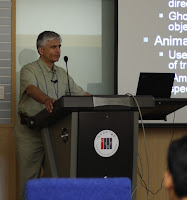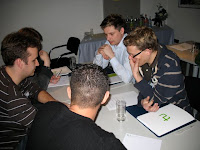Norbert Streitz – Trade-off for creating smartness

Norbert gave an interesting overview of research in the domain of ubicomp based on his personal experience – from Xerox PARC to the disappearing computer. He motivated the transition from Information Design to Experience Design. Throughout the work we see a trade-off between providing “smart support” to the user and “privacy” (or control over privacy). One of the questions if we will re-invent privacy or if it will become a commodity…
As one of the concrete examples Norbert introduced the Hello.Wall done in the context Ambient Agoras [1]. This again brought up the discussion of public vs. private with regard to the patterns that are displays. (
photos of some slides from Norbert’s talk)
[1] Prante, T., Stenzel, R., Röcker, C., Streitz, N., and Magerkurth, C. 2004. Ambient agoras: InfoRiver, SIAM, Hello.Wall. In CHI ’04 Extended Abstracts on Human Factors in Computing Systems (Vienna, Austria, April 24 – 29, 2004). CHI ’04. ACM, New York, NY, 763-764. DOI=
http://doi.acm.org/10.1145/985921.985924 (
Video Hello.Wall)

I gave a talk on “Human Interaction in Ubicomp -Magic beyond the screen” highlighting work in user interfaces beyond the screen that we did over the last years. It is motivated by the facts that classical limitations in computer science (e.g. frame rate, processing, storage) are getting less and less important to many application areas and that the human computer interaction becomes in many areas the critical part of the system.
In my talk I suggested using “user illusion” as a design tool for user interfaces beyond the desktop. This involves two steps: 1) describe precisely the user illusion the application will create and the 2) Investigate what parameters have an influence on the quality of the created user illusion for the application. (
photos of some slides from Albrecht’s talk,
Slides in PDF)

His talk focused on the domain of virtual reality with a focus on learning/training applications. One central thing I learned is that the timing of non-verbal cues (e.g. nodding) is very crucial to produce an engagement in speaking with an agent. This may also be interesting for other forms of computer created feedback.
He gave a specific example on how assigning blame works. It was really interesting to see that there are solid theories in this domain that can be concretely used to design novel interfaces. He argues that appraisal theory can explain people’s emotional states and this could improve context-awareness.
He showed an example of emotional dynamics and it is amazing how fast emotion happen. One of the ways of explaining this is to look at different dynamics: dynamics in the world, dynamics in the perceived world relationship, and dynamic through action. (
photos of some slides from Jonathan’s talk)

Motivated by the vision that after the personal computer we will see the “Personal Robot” Daijin investigates natural ways to interact with robots. For vision based interaction with robots he named a set of difficulties, in particular: people are moving, robots are moving, and the illuminations and distances are variable. The proposed approach is to generate a pose, expression, and illumination specific active appearance model.
He argues that face detection is a basic requirement for vision based human robot interaction. The examples he showed in demo movie were very robust with regard to movement, rotation, and expression and it works for very variable distances. The talk contained further examples of fast face recognition and recognition of simple head gestures. Related to our research it seems that such algorithms could be really interesting in creating context-aware outdoor advertisement. (
photos of some slides from Daijin’s talk)
Steven Feiner – AR for prototyping UIs

Steven showed some work mobile projector and mobile device interaction, were they used augmented reality for prototyping different interaction methods. He introduced Spot-light (position based interaction), orientation based interaction and widget-based interaction for an arm mounted projector. Using the synaptic touchpad and projection may also be an option for our car-ui related research. For interaction with a wrist device (e.g. a watch) he introduced the string-based interaction which is a simple but exciting idea. You pull out a string of a device and the distances as well as the direction are the resulting input parameters [2].
In a further example Steven showed a project that supports field work on identification of plants using capture (of the image of the real leaf), comparison with the data base and matching out of a subset that matches the features. Their prototype was done on a tablet and he showed ideas how to improve this with AR; it is very clear that this may also an interesting application (for the general user) on the mobile phone.
New interfaces and in particular gestures are hard to explore – if you have no idea what is supported by the system. In his example on visual hint for tangible gestures using AR Steven showed interesting options in this domain. One approach follows a “preview style” visualizations – they called it ghosting. (
photos of some slides from Stevens’s talk)
[2] Blasko, G., Narayanaswami, C., and Feiner, S. 2006. Prototyping retractable string-based interaction techniques for dual-display mobile devices. In Proceedings of the SIGCHI Conference on Human Factors in Computing Systems (Montréal, Québec, Canada, April 22 – 27, 2006). R. Grinter, T. Rodden, P. Aoki, E. Cutrell, R. Jeffries, and G. Olson, Eds. CHI ’06. ACM, New York, NY, 369-372. DOI=
http://doi.acm.org/10.1145/1124772.1124827 [3] White, S., Lister, L., and Feiner, S.Visual Hints for Tangible Gestures in Augmented Reality.Proc. ISMAR 2007 IEEE and ACM Int. Symp. on Mixed and Augmented Reality, Nara Japan, November 13-16, 2007. (
youtube video)
Finally some random things to remember:
- Richard W. DeVaul did some work on subliminal user interfaces – working towwrds the vision of zero attention UIs [4]
- Jacqueline Nadel (development psychologist) did studies on emotions between parents and infants using video conferencing
- V2 – Toward a Universal Remote Console Standard http://myurc.org/whitepaper.php
- iCat and Gaze [5]
[4] Richard W. DeVaul. The Memory Glasses: Wearable Computing for Just-in-Time Memory Support. PhD Thesis. MIT 2004. http://devaul.net/~rich/DeVaulDissertation.pdf
[5] Poel, M., Breemen, A.v., Nijholt, A., Heylen, D.K., & Meulemans, M. (2007). Gaze behavior, believability, likability and the iCat. Proceedings Sixth Workshop on Social Intelligence Design: CTIT Workshop Proceedings Series (pp. 109–124). http://www.vf.utwente.nl/~anijholt/artikelen/sid2007-1.pdf
 Monday and Tuesday I organized together with Gernot A. Fink a PhD awayday for students in computer science of the Universities Bochum, Dortmund and Duisburg-Essen. With about 30 PhD students and some professors we went to Bommerholz, where the University of Dortmund has a small retreat.
Monday and Tuesday I organized together with Gernot A. Fink a PhD awayday for students in computer science of the Universities Bochum, Dortmund and Duisburg-Essen. With about 30 PhD students and some professors we went to Bommerholz, where the University of Dortmund has a small retreat. Overall it became very clear that computer science is still the subject to study! The career opportunities are interesting, exciting and very good. Nevertheless there is always a downside to things – whatever way you choose you have to work hard 🙂
Overall it became very clear that computer science is still the subject to study! The career opportunities are interesting, exciting and very good. Nevertheless there is always a downside to things – whatever way you choose you have to work hard 🙂  We had a further talk “Gutenberg over? The metamorphose scientific publishing” by Herrmann Engesser from Springer-Verlag. He showed in an interesting way how much change has happened in the last 40 years to publishing. The example of the Encyclopedia Britannica and the Brockhaus Encyclopedia demonstrates impressively that it is impossible to ignore changes in technology and stay successful in business. Looking at many newspapers one can only wonder when the will realize it.
We had a further talk “Gutenberg over? The metamorphose scientific publishing” by Herrmann Engesser from Springer-Verlag. He showed in an interesting way how much change has happened in the last 40 years to publishing. The example of the Encyclopedia Britannica and the Brockhaus Encyclopedia demonstrates impressively that it is impossible to ignore changes in technology and stay successful in business. Looking at many newspapers one can only wonder when the will realize it.  Besides the invited talks we had three poster sessions. In each session 9 students presented their work. We started with 90 seconds presentations and then had discussions over the posters. As we had topics from all areas in Computer science I first expected that this may be pretty boring – but it was surprisingly interesting. I learned a lot about bio-informatics, learning algorithms, data mining, robotics and security over the last two days. Things I would never have read – but getting it explained in the context of a concrete PhD project was fun.
Besides the invited talks we had three poster sessions. In each session 9 students presented their work. We started with 90 seconds presentations and then had discussions over the posters. As we had topics from all areas in Computer science I first expected that this may be pretty boring – but it was surprisingly interesting. I learned a lot about bio-informatics, learning algorithms, data mining, robotics and security over the last two days. Things I would never have read – but getting it explained in the context of a concrete PhD project was fun. Our evening program was centered on movies. We first showed a number of snippets from movies (including James Bond, Harry Potter, Star Trek, and Minority Report) where cool technology feature. Then the students had 45 minutes to create new ideas of believable technology gadgets for two films, one to plays in 2011 and the other in 2060. The ideas were fun reaching form manipulated insects, to smart dust, to the exploitation of social networks. If you are Steven Spielberg or someone else who plans a movie feel free to call me – we have a lot of ideas 😉
Our evening program was centered on movies. We first showed a number of snippets from movies (including James Bond, Harry Potter, Star Trek, and Minority Report) where cool technology feature. Then the students had 45 minutes to create new ideas of believable technology gadgets for two films, one to plays in 2011 and the other in 2060. The ideas were fun reaching form manipulated insects, to smart dust, to the exploitation of social networks. If you are Steven Spielberg or someone else who plans a movie feel free to call me – we have a lot of ideas 😉








